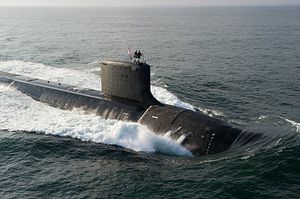The Diplomat author Mercy Kuo regularly engages subject-matter experts, policy practitioners, and strategic thinkers across the globe for their diverse insights into U.S. Asia policy. This conversation with Dr. Trevor Taylor – professorial research fellow in defense management at Royal United Services Institute (RUSI) in London – is the 293rd in “The Trans-Pacific View Insight Series.”
Given Australia’s lack of nuclear infrastructure, analyze Canberra’s decision to opt for nuclear-powered submarines instead of diesel-electric submarines.
This must have been a difficult choice for all three parties to the agreement because of the costs and risks involved.
Nuclear submarines offer a range of operational advantages but mainly they can be deployed without surfacing for a much longer period than diesel submarines. The limits on nuclear submarines’ submerged operations are based only on how much food they can carry and how long a navy can ask its crews to serve on board. On the other hand, they are much more expensive to develop and build and they need specialist workforces to build, operate, and support them.
The precise balance of factors pushing Australia to move to nuclear submarines is not visible from outside the highest levels of its government. Dissatisfaction with the rate of advance with the French submarines, acceptance by the Australian Navy of the advantages of being to deploy a submarine or even two closer to China, realization that even longer-range diesel submarine could not enable this, and confirmation that the U.S. and the U.K. would be willing to cooperate all must have played some part.
Which option – the U.K. Astute submarine or U.S. Virginia-class submarine – is most conducive to Australia’s capabilities?
If submarines could be bought from an operating production line, the Astute would be less expensive and more than adequately capable. However, the production of the Astute is coming to an end and elements of its supply chain may already be unavailable. Neither the U.S. nor the U.K. submarine sector has the capacity for exports, so some capacity to help Australia must be found.
As the governments move into the detail of implementation arrangements, there will be difficult issues of precisely which technology and knowledge the U.K. and the U.S. will transfer. It is possible that the U.S. may want Australia to have a variant of the Los Angeles-class boat rather than its eventual replacement, the Virginia class. Additionally, given Australia’s previous difficulties in generating submarine crews, the smaller crew needed for the Astute (at about three quarters of that linked to the Virginia class) might well enhance the appeal of a U.K.-origin boat.
Explain how Australia would benefit from U.S. and U.K. nuclear submarine technology.
Australia, like many others, seeks to secure employment benefits from its defense programs, but the scale of these would be much affected by how quickly it wants its new boats to be ready for service. As a rough rule, the more work on the submarines’ construction it wants done in Australia, the longer delivery will take. In the long run, if Australia ever opted to pursue civil nuclear power generation, it would have a much larger base of expertise from which to proceed.
With Australia’s decision to acquire Tomahawk missiles, how will larger payloads expand the Australian navy’s strike power?
This may appear as a significant enhancement, since neither Australia’s Hobart destroyers nor its Hunter class vessels under construction has been equipped with missiles with the range to attack land targets in China. The latest Tomahawks have a range in excess of 1,000 miles. However, their use would also require extensive targeting intelligence and it is hard to envisage their being fired except in a coalition context.
Identify key challenges and choices facing Canberra in negotiations with Washington and London during the next 18 months of AUKUS planning.
The agenda will be long and complicated. In basic terms, Australia will have to decide what it wants most and when. Regardless of the proportion of the boats to be built in Australia, the right infrastructure must have been built for their arrival, along with a nuclear regulatory regime under which they will operate. Canberra will need to agree to education and training matters with its two partners. It would clearly be beneficial if Australian personnel could be trained and serve as crew on U.K. and/or U.S. submarines over several years. Australian submarines will need a national commander, but the training and prior multirole experience needed for such a role take years to acquire.
In summary, the key challenges will be political – reconciling Australian expectations with what its partners will be willing to provide – and financial – finding the funding over a sustained period for all that needs to be done. The money task list includes the cost of reaching a settlement with the French Naval Group.
































